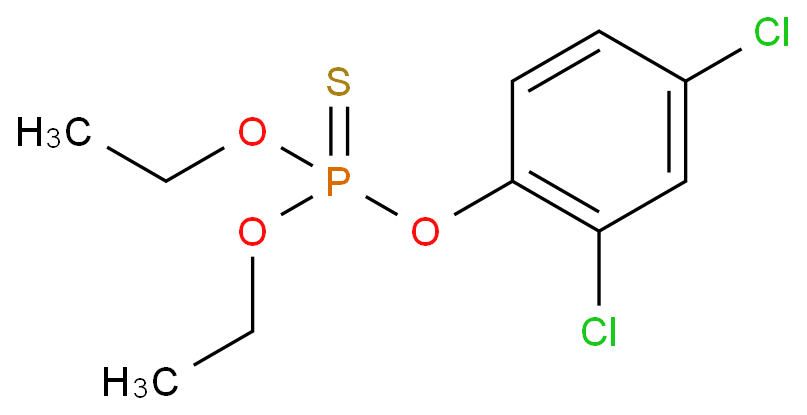DICHLOFENTHION
- Nom de l'IUPAC:(2,4-dichlorophenoxy)-diethoxy-sulfanylidene-λ5-phosphane
- Numéro CAS: 97-17-6
- Masse moléculaire:315.15
1. nom et identifiant
- 1.1 Nom du produit
- DICHLOFENTHION
- 1.2 synonymes
nemacidevc-13o,o-diaéthyl-o-2,4-dichlor-phényl-monothiophosphatO,O-Diaéthyl-O-2,4-dichlorphényl-thionophosphatO,O-Diéthyl O-(2,4- dichlorophényl) thiophosphate O,O-diéthyl-O-(2,4-dichlor-fenyl)-monothiofosfaat o,o-diéthylo-2,4-dichlorophénylthiophosphate O,O-Dietil-O-(2,4-dichloro -fenil)-monotiofosfato 2,4-dichloro-, O-ester de phénol avec le phosphorothioate de O,O-diéthyle
- 1.3 Numéro CAS
- 97-17-6
- 1.4 CID
- 7328
- 1.5 Numéro EINECS
- 202-564-5
- 1.6 Formule moléculaire
- C10H13Cl2O3PS (isomer)
- 1.7 Inchi
- InChI=1S/C10H13Cl2O3PS/c1-3-13-16(17,14-4-2)15-10-6-5-8(11)7-9(10)12/h5-7H,3-4H2,1-2H3
- 1.8 InchiKey
- WGOWCPGHOCIHBW-UHFFFAOYSA-N
- 1.9 Canonique SMILES
- CCOP(=S)(OCC)OC1=C(C=C(C=C1)Cl)Cl
- 1.10 Isomérique SMILES
- CCOP(=S)(OCC)OC1=C(C=C(C=C1)Cl)Cl
2. Propriétés
- 2.1 Densité
- 1.313
- 2.2 Point de fusion
- 100 °C
- 2.3 Point d'ébullition
- bp0.1 164-169 °
- 2.4 Indice de réfraction
- 1.545
- 2.5 Point d'éclair
- 100 °C
- 2.6 PSA
- 69.59000
- 2.7 logP
- 5.32030
- 2.8 Solubilité
- 245ug/L(25 ºC)
- 2.9 Stockage
- 0-6 ° C
3. Sécurité et Manipulation
- 3.1 Codes de danger
- Xn, N
- 3.2 Phrase R
- 22-50 / 53
- 3.3 Phrase S
- 60-61
- 3.4 Catégorie de danger
- 6.1(b)
- 3.5 Description du danger
- H302-H410
- 3.6 RIDADR
- 2783
- 3.7 Wgk Allemagne
- 3
- 3.8 RTECS
- TF0350000
- 3.9 Sécurité et dangers
-
| Codes de danger |
Xn, N |
| Phrase R |
22-50 / 53 |
| Phrase S |
60-61 |
| RIDADR |
2783 |
| RTECS |
TF0350000 |
| Classe de stockage |
6.1 (b) |
| Groupe d'emballage |
III |
| Phytotoxicité |
DL50 chez les rats mâles et femelles (mg/kg) : 185, 172 par voie orale ; 576, 355 par voie cutanée (Gaines, Linder) |
4. MSDS
2.Hazard identification
2.1 Classification of the substance or mixture
Acute toxicity - Oral, Category 4
Hazardous to the aquatic environment, short-term (Acute) - Category Acute 1
Hazardous to the aquatic environment, long-term (Chronic) - Category Chronic 1
2.2 GHS label elements, including precautionary statements
| Pictogram(s) |   |
| Signal word | Warning |
| Hazard statement(s) | H302 Harmful if swallowed H400 Very toxic to aquatic life H410 Very toxic to aquatic life with long lasting effects |
| Precautionary statement(s) | |
| Prevention | P264 Wash ... thoroughly after handling. P270 Do not eat, drink or smoke when using this product. P273 Avoid release to the environment. |
| Response | P301+P312 IF SWALLOWED: Call a POISON CENTER/doctor/\u2026if you feel unwell. P330 Rinse mouth. P391 Collect spillage. |
| Storage | none |
| Disposal | P501 Dispose of contents/container to ... |
2.3 Other hazards which do not result in classification
none
5. Route synthétique
97-17-6Total: 3 Route synthétique
6. Précurseurs et produits
7. informations complémentaires
8. données chimiques calculées
- Masse moléculaire: 315.153181g/mol
- Formule moléculaire: C10H13Cl2O3PS
- Compound Is Canonicalized: True
- XLogP3-AA: null
- Exact Mass: 313.9700078
- Monoisotopic Mass: 313.9700078
- Complexity: 270
- Rotatable Bond Count: 6
- Hydrogen Bond Donor Count: 0
- Hydrogen Bond Acceptor Count: 4
- Topological Polar Surface Area: 59.8
- Heavy Atom Count: 17
- Defined Atom Stereocenter Count: 0
- Undefined Atom Stereocenter Count: 0
- Defined Bond Stereocenter Count: 0
- Undefined Bond Stereocenter Count: 0
- Isotope Atom Count: 0
- Covalently-Bonded Unit Count: 1
- CACTVS Substructure Key Fingerprint: AAADccBwMAJGAAAAAAAAAAAAAAAAAAAAAAAwAAAAAAAAAAABAAAAGgIAACAACAagkCIyBoAAARCAACBCAAACAAAgJUAIiAAGC4gIJiKBExKAMAAkwBEIiAeAQAAAACAAAACACAAAQAAAAQAQAAAAAAAAAA==
9. Fournisseurs recommandés
-
- Products:Manufacture & Supply Biopharm Chemical, Specialty Chemical, PetroChemical.
- Tel:86-592-8883942
- Email:sale@amitychem.com
-
- Products:Pharmaceutical intermediates
- Tel:86-573-85280080
-
- Tel:0577-88377058 88377068
-
-










